Jessie Zevalkink and her fiancé Luke Yeates, sailed from her house to his - 4,800 North Atlantic miles from Michigan to Cornwall
Luke asked me marry him. My feet didn’t touch the ground, I was airborne in saying yes. Within a month we were discussing sailing trips, big sailing trips, the kind of trips that people spend lifetimes planning. Luke is the kind of guy who chases big ideas. He tackles them and they become his reality. His athleticism in this department is impressive.
I was never hankering to cross an ocean. It rested on my mind as a possibility but it wasn’t eating me, in fact I probably had to be gently sold on the idea.
Luckily for Luke, he is a salesman, and a damn good one. My perspective on sailing oceans changed in meeting someone who had an admirable passion for the sea, and a confident familiarity with handling its multiple personalities. I began to think that I, too, had a small fraction of what he had. We had barely sailed together, but knew that we needed to.
I grew up as a leisurely passenger aboard Desireé, my father’s 1962 Pearson Invicta, sailing the Great Lakes. Then, I had no interest whatsoever in the action of sailing, purely catching rays and swimming to land. It wasn’t until five years ago that I sailed a boat alone for the first time. I bought a 1979 Cal 27 with one of my best friends, and we dreamed of taking it to the Bahamas.
Luke had his first taste of sailing as a kid growing up in New Zealand. The first time Luke sailed an Optimist he decided sailing was all he ever wanted to do. He forged sick notes and skipped school to go sailing. As a 12-year-old, he would disappear for lengthy afternoons sailing, much to the annoyance of his family, as he never told them where he was sailing and when he planned to return. He became obsessed, with racing in particular.

I remember the first night I met Luke, at the Annapolis Boat Show. There may have been tequila involved but one conversation I recall was sobering. Luke and a friend had sailed a Hobie cat around Britain at 21 years old, setting a speed record on the way. I understood his extremity; his pushing of boundaries, which made me feel like I had yet to push mine, even though I thought I already had. Simply imagining being on the trampoline of a Hobiefor 28 days straight, soaking wet and freezing, had my mind ping-ponging with questions. I wanted to know everything.
In agreeing to spend the rest of my life with Luke there was no question about my future on the ocean. When I realised what ingredients we had laid out in front of us, I pitched him my brilliant idea: “Let’s sail from my house to your house, Michigan to England, before we get married. The ultimate premarital test!”
I didn’t even have to finish the pitch before Luke was speaking in numbers, routes, seasons, and logistics. I sat my father down and chose my words wisely: “Dad, can we sail your boat to England?”
Desireéis solid, built by wooden boatbuilders during the early days of glass. She is a beautiful design tastefully crafted by Bill Tripp Jr. She is a yawl rig with long overhangs, a big, full bow and a lovely counter stern, with sweeping sheer lines and low freeboard.
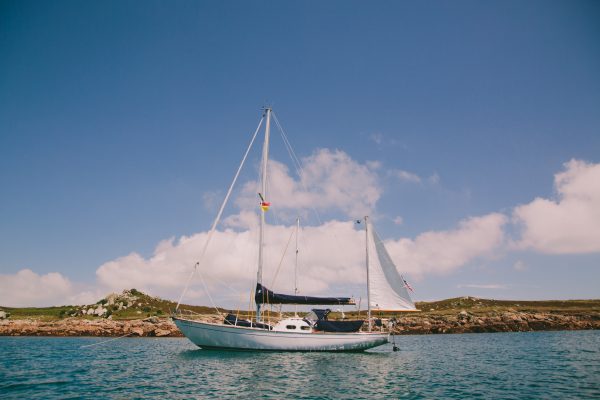
Luke was in love with the demi bulwarks with their mahogany cap rail, essential for keeping all lines on board, not to mention having stopped both of us from sliding off the deck on several occasions. She was designed for the Newport to Bermuda Race, which her sistership won back in the Sixties. This was the first glassfibre design to win an offshore race anywhere. It was guaranteed the boat would be fast and strong enough for any ocean.
The never-ending job list began. Inside an ice-cold storage unit during a northern Michigan winter, we prepped Desireéto cross the Atlantic. With numb fingers we installed self-steering, solar, AIS, a new head, and pieced together a newly rebuilt engine.
We measured the rig for new sails, installed an inner forestay… and the list went on and on. By spring’s first thaw, we launched her and sailed away on 17 April, just a few degrees above freezing.
Our route took us across four of the choppy and unpredictable Great Lakes, out through the ripping currents of the St Lawrence Seaway and into the Atlantic Ocean.
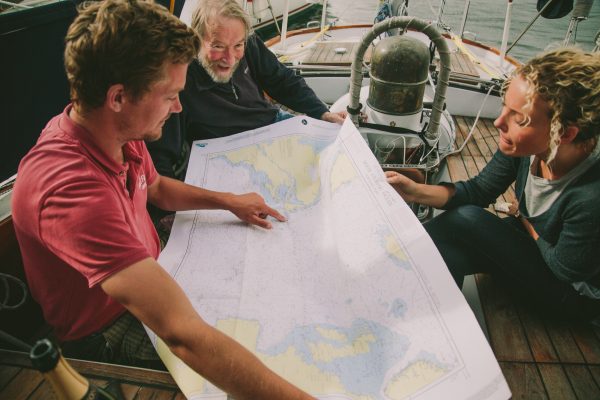
We were to cross the North Atlantic from St Johns in Newfoundland to Falmouth, south-west England. I had never been so terrified and never wanted something so badly. Planning and executing this voyage took everything we had mentally, physically, emotional, and financially. Our relationship orbited Desireé, our conversation rarely straying from the Atlantic Ocean. We were completely consumed.
It took one month to get out of the Great Lakes and over to Montreal, a wicked and arctic experience of frosty decks with both water and air temperatures just a few degrees above freezing. The Great Lakes were fierce, but my motivation to sail the boat to the ocean was to gain the confidence and to prepare for conditions that we expected to be much fiercer.
Heading for ‘Iceberg Alley’
Sailing double-handed on a classic boat was demanding. Our first night out of Quebec City we had to short tack up a narrow shipping channel, all hands required on deck. With 9 knots of current and ships navigating the channel, we both remained awake until the following day. Progress was hampered on several occasions, by headwind gales and wicked tidal currents pushing and shoving us as they pleased. Time was ticking away and we were far behind our ambitious schedule that had been based around career obligations. ‘Iceberg Alley’ was up next, and it was not the place to be rushing.
We opted to sail without radar, agreeing it was just another distraction, another drain on the battery, and another excuse for our eyes not to be on the horizon. A controversial decision? Yes. We entered the iceberg zone on the south coast of Newfoundland where seven bergs had been reported. The sun had set, and I disliked that night more than any other. It was foggy and windy, the kind of fog that messes with your mind. We turned off our running lights to eliminate the back glow, in hopes of seeing just a few more feet ahead of the bow. We dropped all canvas apart from two reefs in the main to slow down. Lightning flashed twice a minute but there was nothing to see besides birds circling, fog, wind, and blackness.
We agreed to take shorter shifts and I went down below to try and rest. I tried to sleep, unsuccessfully, and I smelled ice. I didn’t say anything because I didn’t trust that it was possible to smell ice.
When we switched shifts we sat together for a few moments in the companionway, looking ahead into the fog. I squinted to focus, and gripped Luke’s arm. “Look, look!” Just 200 yards away a wall of white passed down the port side of the boat. Visibility was so poor we hadn’t spotted it until we were already passing it. A chunk of glacier the size of a hotel silently drifted back out of sight.
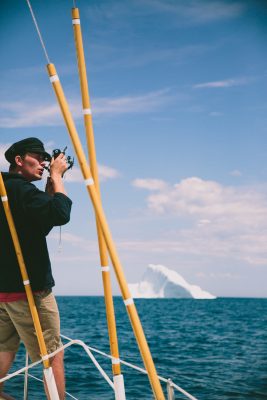
It was terrifying and magnificent. I’m just a girl from Michigan; this was hard for me to wrap my head around. We decided to stop on Newfoundland’s south coast the following morning and review our iceberg tactics.
The anticipation of crossing the ocean was the worst of it. It was mental preparation for ultimate disaster. An uninsured, borrowed, classic yawl in which I held huge emotional value, captained by two opposites: Luke, a dinghy racer and accomplished super sailor who thrives on speed and efficiency; and myself, the slowest coastal cruiser known to man who knew a thing or two about diesel engines and virtually nothing about sails, a green ocean sailor.
By the time we reached St Johns, Newfoundland, we had learned a lot about the boat, and even more about each other. We had done our studying. We’d read our books and had a thousand conversations with experienced sailors. We took every precaution. Information was everywhere, it was just up to us to decide on the validity of that information, to agree or disagree.
We had to make our own decisions based on our own abilities and our own boat, no one else’s. This is tricky.
The whole reason for sailing all the way to St Johns, Newfoundland, was so that we could sail the great circle route over the North Atlantic, the fastest possible crossing for that section of ocean. Although it is the shortest mileage, timing is tricky. Leave in June and there are icebergs everywhere; wait too long and the ice has gone but it’s hurricane season. You have two choices: mountains of water, or mountains of ice. We decided ice would be better as you can sail around ice… if you can see it. We kept a diligent lookout for the first 600 miles until we were well clear of the Labrador Current.
Violently ill for the first two nights, it took five days for my body to adjust to the swells and sleep patterns. Energy and motivation was restored after week one and Luke and I found our divine rhythm. We were in a water park along for the ride, fine-tuning the sails and the Hydrovane. Days would go by on the same tack with only the most minute of adjustments. Gales and torrential rain would pass by, stirring up the seas and making the simplest of tasks effectively impossible, only to be followed by hours spent floating upon a sea of mercury, rocking side to side in the leftover swells, completely becalmed.
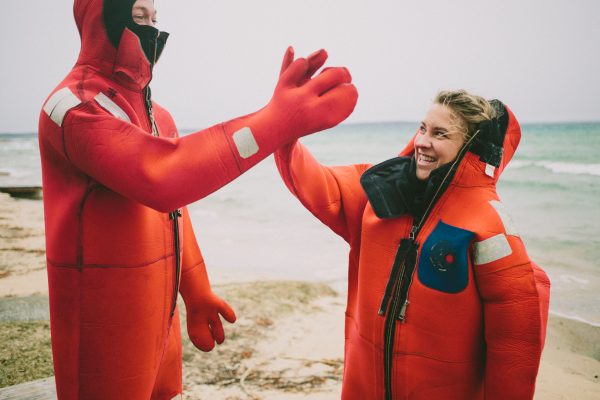
It took 17 days to cross the ocean. Two days of headwinds, 15 days downwind, three days becalmed. We never saw waves over 15ft, or winds higher than 45 knots. We did see three icebergs and six cargo ships, over 102 watch changes. I kept waiting for it to get worse, to meet God in a 30ft wave, to be locked inside the cabin under bare poles. But it never got worse and I didn’t meet any gods. The only thing that locked us inside was rain. We considered ourselves extremely lucky.
Desireécame alive once out on the ocean, beam reaching in 35-40 knots of wind heavily reefed, the staysail set with the Hydrovane self-steering gear engaged, and she proved herself as a truly excellent ocean-going yacht.
However, in under 10 knots of wind the boat would start to wallow in the dying swell, and it took a full sail change using the big asymmetric and the mizzen staysail to get her moving again. We had a bombproof set of Hyde Sails and went through every possible sail combination several times. We tried goosewinged, Twizzlerigged (double genoa goosewinged), poled back asymmetric main, mizzen and mizzen staysail, sometimes when really windy just sailing on the staysail only. The inner forestay and staysail combination was essential for this boat and this trip. The Hydrovane was our best friend and our Mazu weather app prepared us for the gales.
Making landfall
On the 17th evening we flew by the legendary Bishop Rock and made landfall in the Isles of Scilly under moonlight. We dropped the hook in St Agnes under the stars. We drank our last two beers and watched the sunrise in the stillest of waters.
It was the greatest reward, and the greatest sense of accomplishment. After 88 days since leaving Michigan and 4,800 miles in total from ‘my house’ to ‘his house’, Luke and I had solidified our joint capabilities. We had short-cut years of married life getting to know each other’s ‘worst’ selves. In very close quarters, we were forced into endless physically and mentally uncomfortable scenarios. When we made it to the other side, I can honestly say I’d never felt so complete, so entirely connected to another person, so in tune with how I wanted to spend my life, my time, my money.
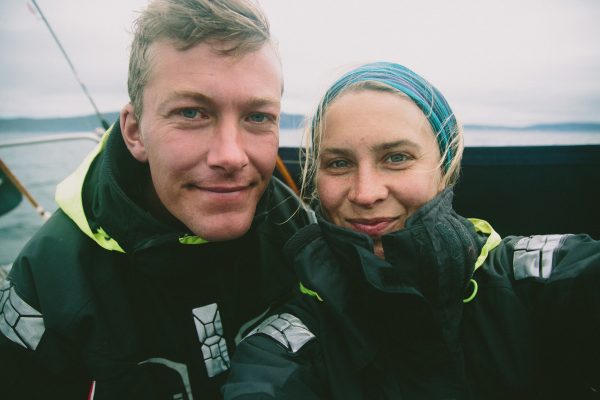
We believe that any decent coastal sailor is capable of crossing the Atlantic, it is truly simpler than many of the hazards that coastal sailing brings. I never expected to feel so relaxed in the middle of an ocean; I became most anxious when we closed in on land. The nervousness of actually going often forces you to over-prepare, and all those precautions stacked up make for an ultra-safe vessel. And once you understand your ability to cross an ocean, you can go anywhere.
We have agreed to sail Desireéback to my father in Michigan. Now it’s just a question of if we’re going to take the long way or the short way home.




